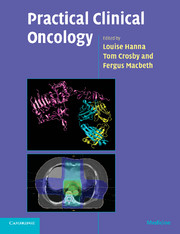Book contents
- Frontmatter
- Contents
- List of contributors
- Preface
- Acknowledgements
- Abbreviations
- 1 Practical issues in cytotoxic chemotherapy usage
- 2 Biological treatments in cancer
- 3 Hormones in cancer
- 4 Radiotherapy planning
- 5 Research in cancer
- 6 Oncological emergencies
- 7 Palliative care
- 8 Head and neck
- 9 Oesophagus
- 10 Stomach
- 11 Liver, gallbladder and biliary tract
- 12 Exocrine pancreas
- 13 Colon and rectum
- 14 Anus
- 15 Gastrointestinal stromal tumours
- 16 Breast
- 17 Kidney
- 18 Bladder
- 19 Prostate
- 20 Testis
- 21 Penis
- 22 Ovary
- 23 Body of the uterus
- 24 Cervix
- 25 Vagina
- 26 Vulva
- 27 Gestational trophoblast tumours
- 28 Lung
- 29 Mesothelioma
- 30 Soft tissue and bone tumours in adults
- 31 The lymphomas and myeloma
- 32 Central nervous system
- 33 Skin cancer other than melanoma
- 34 Melanoma
- 35 Thyroid
- 36 Neuroendocrine tumours
- 37 Cancer in children
- 38 Cancer of unknown primary
- 39 The use of radiotherapy in the treatment of benign conditions
- Multiple choice questions
- Multiple choice answers
- Index
- References
32 - Central nervous system
Published online by Cambridge University Press: 23 December 2009
- Frontmatter
- Contents
- List of contributors
- Preface
- Acknowledgements
- Abbreviations
- 1 Practical issues in cytotoxic chemotherapy usage
- 2 Biological treatments in cancer
- 3 Hormones in cancer
- 4 Radiotherapy planning
- 5 Research in cancer
- 6 Oncological emergencies
- 7 Palliative care
- 8 Head and neck
- 9 Oesophagus
- 10 Stomach
- 11 Liver, gallbladder and biliary tract
- 12 Exocrine pancreas
- 13 Colon and rectum
- 14 Anus
- 15 Gastrointestinal stromal tumours
- 16 Breast
- 17 Kidney
- 18 Bladder
- 19 Prostate
- 20 Testis
- 21 Penis
- 22 Ovary
- 23 Body of the uterus
- 24 Cervix
- 25 Vagina
- 26 Vulva
- 27 Gestational trophoblast tumours
- 28 Lung
- 29 Mesothelioma
- 30 Soft tissue and bone tumours in adults
- 31 The lymphomas and myeloma
- 32 Central nervous system
- 33 Skin cancer other than melanoma
- 34 Melanoma
- 35 Thyroid
- 36 Neuroendocrine tumours
- 37 Cancer in children
- 38 Cancer of unknown primary
- 39 The use of radiotherapy in the treatment of benign conditions
- Multiple choice questions
- Multiple choice answers
- Index
- References
Summary
Introduction
This chapter describes the management of tumours in adults in the following anatomical areas: cerebral convexity and cerebral hemispheres, the skull base, the pituitary, the pineal region and the spinal cord.
Central nervous system (CNS) tumours are heterogeneous. The terms malignant and benign are not very useful because:
Even small slowly growing tumours can cause severe symptoms because the brain is enclosed in a rigid skull.
Surgery can be difficult because many tumours are infiltrating and often lie close to critical structures.
Most of these tumours rarely, if ever, metastasise outside the CNS.
Slow-growing tumours may transform into a much more aggressive variant.
This chapter does not deal with metastatic disease to the CNS that is considered in other relevant chapters, although management of cerebral metastases that require specialist neuro-oncology input is discussed briefly. CNS tumours in children are considered in Chapter 37 (see p. 432).
Anatomy
The tentorium separates the supratentorial from the infratentorial areas of the brain. The motor and sensory cortices lie at the central sulcus. Broca's area (frontal, above the lateral sulcus) is responsible for expressive loss of speech, and Wernicke's area (temporal, posterior end of the lateral sulcus) is responsible for receptive loss of speech. The ventricular system is lined with ependyma. CSF travels from the third to the fourth ventricle through the cerebral aqueduct and from the fourth ventricle to the subarachnoid space through the foramina of Magendie (median) and Luschka (lateral).
The anterior and intermediate lobes of the pituitary arise from Rathke's pouch.
- Type
- Chapter
- Information
- Practical Clinical Oncology , pp. 370 - 381Publisher: Cambridge University PressPrint publication year: 2008



